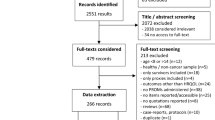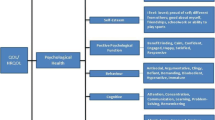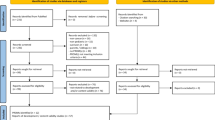Abstract
Objective
To identify and appraise all published quality of life (QOL) measures developed for use with children with cancer and childhood cancer survivors.
Methods
MEDLINE, CINAHL, EMBASE, PsycINFO, CancerLit, and Sociological Abstracts were searched from the inception of each database to 15 June 2009. Included articles were ones that described the development and/or psychometric evaluation of a QOL measure developed for use with children with cancer or childhood cancer survivors. Articles were appraised for adherence to internationally recommended guidelines for item generation, item reduction, and psychometric evaluation.
Results
Thirteen QOL questionnaires were identified by our search. Eleven measures are applicable to measuring QOL in children with any type of cancer, and two are specific to children with brain cancer. Four measures can be used to measure QOL in children undergoing cancer treatment, six can be used with children on or off treatment, and three are specific to childhood cancer survivors. While all measures underwent some degree of formal development and validation, item generation often did not involve children with cancer or their parents, and a number of measures did not describe or utilize recommended methods for item reduction and psychometric evaluation.
Conclusions
Most of the measures identified in this review were designed to measure QOL concerns of children with any type of cancer and at any time, during treatment or survivorship. Our findings can help researchers and clinicians identify scientifically sound measures.
Similar content being viewed by others
References
Hinds PS, Burghen EA, Haase JE, Phillips CR (2006) Advances in defining, conceptualizing, and measuring quality of life in pediatric patients with cancer. Oncol Nurs Forum 33(1 Suppl):23–29
Scientific Advisory Committee of the Medical Outcomes Trust (2002) Assessing health status and quality of life instruments: attributes and review criteria. Qual Life Res 11(3):193–205
Solans M, Pane S, Estrada M et al (2007) Health-related quality of life measurement in children and adolescents: a systematic review of generic and disease-specific instruments. Value Health; (EPub ahead of print)
Spieth LE, Harris CV (1996) Assessment of health related quality of life in children and adolescents: an integrative review. J Pediatr Psychol 21(2):175–193
Connolly MA, Johnson JA (1999) Measuring quality of life in paediatric patients. PharmacoEconomics 16(6):605–625
Eiser C, Mohay H, Morse R (2000) The measurement of quality of life in young children. Child Care Health Dev 26(5):401–414
Eiser C, Morse R (2001) Quality-of-life measures in chronic diseases of childhood. Health Technol Assess 5(4):1–157
Harding L (2001) Children’s quality of life assessments: a review of generic and health related quality of life measures completed by children and adolescents. Clin Psychol Psychother 8(2):79–96
Schmidt LJ, Garrat AM, Fitzpatrick R (2002) Child/parent-assessed population health outcome measures: a structured review. Child Care Health Dev 28(3):227–237
Clarke S, Eiser C (2004) The measurement of health-related quality of life (QOL) in paediatric clinical trials: a systematic review. Health Qual Life Outcomes 2:66
Matza LS, Swensen AR, Flood EM, Secnik K, Kline Leidy N (2004) Assessment of health-related quality of life in children: a review of conceptual, methodological, and regulatory issues. Value Health 7(1):79–92
Rajmil L, Herdman M, Fernandez De Sanmamed M et al (2004) Generic health-related quality of life instruments in children and adolescents: a qualitative analysis of content. J Adolesc Health 34(1):37–45
De Civita M, Regier D, Alamgir AH, Anis AH, FitzGerald MJ, Marra CA (2006) Evaluating health-related-quality-of-life studies in paediatric populations. Some conceptual, methodological and developmental considerations and recent applications. PharmacoEconomics 23(7):659–685
Creeman J, Eiser C, Blades M (2006) Characteristics of health-related self-report measures for children aged three to eight years: a review of the literature. Qual Life Res 15(4):739–754
Davis E, Waters E, Mackinnon A et al (2006) Paediatric quality of life instruments: a review of the impact of the conceptual framework on outcomes. Dev Med Child Neurol 48(4):311–318
Ravens-Sieberer U, Erhart M, Wille N, Wetzel R, Nickel J, Bullinger M (2006) Generic health-related quality-of-life assessment in children and adolescents. PharmacoEconomics 24(12):1199–1220
Raat H, Mohangoo AD, Grootenhuis MA (2006) Pediatric health-related quality of life questionnaires in clinical trials. Curr Opin Allergy Clin Immunol 6(3):180–185
Pickard AS, Topfer L, Feeney DH (2004) A structured review of studies of health-related quality of life and economic evaluation in pediatric acute lymphoblastic leukemia. J Natl Cancer Inst Monographs 33:102–24
United States Food and Drug Administration (2006) Patient reported outcome measures: use in medical product development to support labelling claims. www.fda.gov/cber/gdlns/prolbl.pdf.
Ward-Smith P, Hamlin J, Bartholemew J, Stegenga K (2007) Quality of life among adolescents with cancer. J Pediatr Oncol Nurs 24(3):166–171
Ward-Smith P, McCaskie B, Rhoton S (2007) Adolescent-evaluated quality of life: a longitudinal study. J Pediatr Oncol Nurs 24(6):329–333
Phipps S, Dunavant M, Jayawardene D, Srivastiva DK (1999) Assessment of health-related quality of life in acute in-patient settings: use of the BASES instrument in children undergoing bone marrow transplantation. Int J Cancer Suppl 12:8–24
Parsons SK, Shih MC, Mayer DK et al (2005) Preliminary psychometric evaluation of the Child Health Ratings Inventory (CHRIs) and Disease-Specific Impairment Inventory-Hematopoietic Stem Cell Transplantation (DSII-HSCT) in parents and children. Qual Life Res 14(6):1613–1625
Rodriguez ED, González BG, Ruiz-Gálvez SOPT (1996) Evaluación de la calidad de vida en niños enfermos de cáncer mediante ECVNO y POQOLS. Psiquis 17:383–388
Armstrong DF, Toledano SR, Miloslavich K, Lackman-Zeman L, Levy JD, Gay CL, Schuman WB, Fishkin PE (1999) The Miami pediatric quality of life questionnaire: parent scale. Int J Cancer Suppl 12:11–17
Bhatia S, Jenney ME, Wu E, Bogue MK, Rockwood TH, Feusner JH, Friedman DL, Robison LL, Kane RL (2004) The Minneapolis-Manchester quality of life instrument: reliability and validity of the youth form. J Pediatr 145(1):39–46
Bhatia S, Jenney ME, Bogue MK, Rockwood TH, Feusner JH, Friedman DL, Robison LL, Kane RL (2002) The Minneapolis-Manchester quality of life instrument: reliability and validity of the adolescent form. J Clin Oncol 20(24):4692–4698
Hutchings HA, Upton P, Cheung WY, Maddocks A, Eiser C, Williams JG, Russell IT, Jackson S, Jenney ME (2007) Adaptation of the Manchester-Minneapolis quality of life instrument for use in the UK population. Arch Dis Child 92(10):855–860
Hutchings HA, Upton P, Cheung WY, Maddocks A, Eiser C, Williams JG, Russell IT, Jackson S, Jenney ME (2008) Development of a parent version of the Manchester-Minneapolis quality of life survey for use by parents and carers of UK children: MMQL-UK (PF). Health Qual Life Outcomes 6:19–26
Varni JW, Burwinkle TM, Katz ER, Meeske K, Dickinson P (2002) The PedsQOL™ in pediatric cancer. Reliability and validity of the pediatric quality of life inventory™ generic core scales, multidimensional fatigue scale, and cancer module. Cancer 94(7):2090–2106
Varni JW, Katz ER, Seid M, Quiggins DJ, Friedman-Bender A, Castro CM (1998) The Pediatric Cancer Quality of Life Inventory (PCQOL). I. Instrument development, descriptive statistics, and cross-informant variance. J Behav Med 21(2):179–204
Varni JW, Katz ER, Seid M, Quiggins DJ, Friedman-Bender A (1998) The Pediatric Cancer Quality of Life Inventory-32 (PCQOL-32). I. Reliability and validity. Cancer 82(6):1184–1196
Varni JW, Rode CA, Seid M, Katz ER, Friedman-Bender A, Quiggins DJ (1999) The Pediatric Cancer Quality of Life Inventory-32 (PCQOL-32). II. Feasibility and range of measurement. J Behav Med 22(4):397–406
Felder-Puig R, Frey E, Proksch K, Varni JW, Garner H, Topf R (2004) Validation of the German version of the Pediatric Quality of Life Inventory™ (PedsQOL™) in childhood cancer patients off treatment and children with epilepsy. Qual Life Res 13(1):223–234
Scarpelli AC, Paiva SM, Pordeus IA, Ramos-Jorge ML, Varni JW, Allison PJ (2008) Measurement properties of the Brazilian version of the Pediatric Quality of Life Inventory (PedsQL™) cancer module scale. Health Qual Life Outcomes 6:7–17
Seid M, Varni JW, Rode CA, Katz ER (1999) The pediatric cancer quality of life inventory: a modular approach to measuring health-related quality of life in children with cancer. Int J Cancer Suppl 12:17–76
Palmer SN, Meeske KA, Katz ER, Burwinkle TM, Varni JW (2007) The PedsQOL™ brain tumor module: initial reliability and validity. Pediatr Blood Cancer 49(3):287–293
Lai J, Cella D, Tomita T, Bode RK, Newmark M, Goldman S (2007) Developing a health-related quality of life instrument for childhood brain tumor survivors. Childs Nerv Syst 23(1):47–57
Goodwin DAJ, Boggs SR, Graham-Pole J (1994) Development and validation of the Pediatric Oncology Quality of Life Scale. Psychol Assess 6(4):321–328
Bijttebier P, Bercruysse T, Vertommen H, Van Gool SW, Uyttebroeck A, Brock P (2001) New evidence on the reliability and validity of the Pediatric Oncology Quality of Life Scale. Psychol Health 16(4):461–469
Calaminus G, Weinspach S, Teske C, Göbel U (2000) Quality of life in children and adolescents with cancer. Klin Padiatr 212(4):211–215
Yeh C, Chao K, Hung L (2004) The Quality of Life for Cancer Children (QOLCC) in Taiwan (part I): reliability and construct validity by confirmatory factor analysis. Psycho-Oncology 13(3):161–170
Yeh C, Hung L, Chao K (2004) The Quality of Life for Cancer Children (QOLCC) for Taiwanese children with cancer (part II): feasibility, cross-informants variance and clinical validity. Psycho-Oncology 13(3):171–176
Yeh C, Hung L (2003) Construct validity of newly developed quality of life assessment instrument for child and adolescent cancer patients in Taiwan. Psycho-Oncology 12(4):345–356
Watson M, Edwards L, von Essen L, Davidson J, Day R, Pinkerton R (1999) Development of the Royal Marsden Hospital Paediatric Oncology Quality of Life Questionnaire. Int J Cancer Suppl 12:65–70
Phipps S, Hinds PS, Channell S, Bell GL (1994) Measurement of behavioral, affective, and somatic responses to pediatric bone marrow transplantation: development of the BASES scale. J Pediatr Oncol Nurs 11(3):109–117
Boggs SR, Durning P (1998) The Pediatric Oncology Quality of Life Scale: development and validation of a disease-specific quality of life measure. In: Drotar D (ed) Measuring health-related quality of life in children and adolescents: implications for research and practice. Lawrence Erlbaum Associates Publishers, New Jersey, pp 187–202
Upton P, Lawford J, Eiser C (2008) Parent-child agreement across child health-related quality of life instruments: a review of the literature. Qual Life Res 17:895–913
Rasch G (1960) Probabilistic models for some intelligence and attainment tests. Danish Institute for Education Research, Copenhagen Chicago
Lord FM, Novick MR (1968) Statistical theories of mental test scores. Addison, Reading
Hobart JC, Cano SJ, Zajicek JP, Thompson AJ (2007) Rating scales as outcome measures for clinical trials in neurology: problems, solutions and recommendations. Lancet Neurol 6(12):1094–1105
Wainer H, Dorans NJ, Flaugher R et al. (eds) (1990) Computerized adaptive testing: a primer. Lawrence Erlbaum Associates, Hillsdale, New Jersey
Revicki DA, Cella DF (1997) Health status assessment for the twenty-first century: item response theory, item banking and computer adaptive testing. Qual Life Res 6(6):595–600
Author information
Authors and Affiliations
Corresponding author
Additional information
This study was funded by a grant from the Canadian Cancer Society. Anne Klassen is a recipient of Canadian Institute of Health Research career award. We acknowledge the contribution of Maureen Rice for her help with the literature search.
Rights and permissions
About this article
Cite this article
Klassen, A.F., Strohm, S.J., Maurice-Stam, H. et al. Quality of life questionnaires for children with cancer and childhood cancer survivors: a review of the development of available measures. Support Care Cancer 18, 1207–1217 (2010). https://doi.org/10.1007/s00520-009-0751-y
Received:
Accepted:
Published:
Issue Date:
DOI: https://doi.org/10.1007/s00520-009-0751-y




